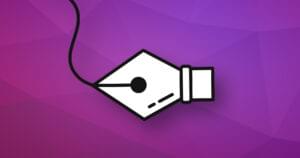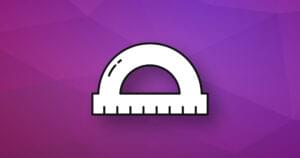How To Draw An iPhone App Icon In Illustrator
Following on from yesterday’s post on how to draw a vector iPhone, here’s how to make an iPhone style icon in Illustrator.
1. Use the Rounded Rectangle to draw a square with round corners. Hold down the Shift key as you drag to create a square.
![]()
2. Open the Gradient and Color palettes. Make sure the square is still selected. Create a linear gradient with 3 shades of the same color, starting with the lightest color on the left hand side. To change a color stop, first, click on the color stop, and then click on the color you want on the Color palette. To add an extra color stop, simply click under the gradient slider.
3. Set the Stroke color to None.
Here’s how my palettes and square look: ![]()
4. Make a copy of the square and paste it directly on top of the first square.
5. Draw a black-filled ellipse above the square.
![]()
6. Select both the square and the ellipse, then open the Pathfinder palette and click on the Divide icon. ![]()
![]()
7. Choose Object > Ungroup, to ungroup the divided objects then. Delete the top of the ellipse and the bottom part of the square. ![]()
8. Select the new top of the square and fill it with a linear black and white gradient. (White at the top grey at the bottom). Set the blending mode to Screen and the Opacity to 80%. ![]()
The button should look a bit like this: ![]()
Now you can add a logo or symbol to the button. Whatever you choose to add, make sure that is sits beneath the top gradient. I used a webding for the ambulance. ![]()
9. The icons sit on a dark screen and generally have some text underneath them. Use Helvetica or Arial if you don’t have that font on your computer.
![]()
10. Once you’ve made your icon you can select all parts and group them. Then add them to your iPhone vector image, or your web page if you want to use the icons for that.
Related Reading:
Frequently Asked Questions (FAQs) about Drawing an iPhone Icon in Illustrator
How can I create a new project in Adobe Illustrator on my iPhone?
To create a new project in Adobe Illustrator on your iPhone, first, open the Adobe Illustrator app. Tap on the “+” icon located at the bottom of the screen. You will be presented with several options for the size and orientation of your new project. Choose the one that best suits your needs. Once you’ve made your selection, tap on “Create Document” to start your new project.
Can I use Adobe Capture in conjunction with Adobe Illustrator to create an iPhone icon?
Yes, you can use Adobe Capture in conjunction with Adobe Illustrator to create an iPhone icon. Adobe Capture allows you to capture shapes, colors, and patterns from the real world and convert them into digital assets that you can use in your Illustrator projects. This can be particularly useful when creating icons, as it allows you to incorporate unique and personalized elements into your designs.
How can I add gradients to my iPhone icon in Adobe Illustrator?
To add gradients to your iPhone icon in Adobe Illustrator, first, select the object you want to apply the gradient to. Then, go to the “Gradient” panel on the right side of the screen. Here, you can choose between a linear or radial gradient, select the colors for your gradient, and adjust the angle and position of the gradient.
What are some tips for creating a realistic iPhone icon in Adobe Illustrator?
When creating a realistic iPhone icon in Adobe Illustrator, it’s important to pay attention to details. Use reference images to ensure that your proportions are accurate. Add gradients and shadows to give your icon depth and dimension. Also, consider adding subtle textures to make your icon look more realistic.
Can I use Adobe Illustrator Draw to create an iPhone icon?
Yes, you can use Adobe Illustrator Draw to create an iPhone icon. Adobe Illustrator Draw is a vector drawing app that allows you to create and edit vector graphics on your iPhone. It offers a range of tools and features that can be used to create detailed and professional-looking icons.
How can I export my iPhone icon from Adobe Illustrator?
To export your iPhone icon from Adobe Illustrator, go to the “File” menu and select “Export”. Choose the format you want to export your icon in, such as PNG or JPEG. Then, choose the location where you want to save your exported icon and click “Export”.
Can I use Adobe Fresco to create an iPhone icon?
While Adobe Fresco is primarily a painting and drawing app, it can be used to create simple icons. However, for more complex and detailed icons, Adobe Illustrator or Adobe Illustrator Draw would be more suitable.
How can I add shadows to my iPhone icon in Adobe Illustrator?
To add shadows to your iPhone icon in Adobe Illustrator, select the object you want to add a shadow to. Then, go to the “Effect” menu, select “Stylize”, and then “Drop Shadow”. Here, you can adjust the settings for your shadow, such as the opacity, offset, and blur.
Can I use Adobe Illustrator on my iPad to create an iPhone icon?
Yes, you can use Adobe Illustrator on your iPad to create an iPhone icon. The iPad version of Adobe Illustrator offers the same powerful vector editing tools as the desktop version, making it a great option for creating icons on the go.
How can I add textures to my iPhone icon in Adobe Illustrator?
To add textures to your iPhone icon in Adobe Illustrator, you can use the “Swatches” panel to apply pre-made textures, or you can create your own textures using the “Brushes” panel. You can also import textures from other sources and apply them to your icon using the “Place” command under the “File” menu.
Jennifer Farley is a designer, illustrator and design instructor based in Ireland. She writes about design and illustration on her blog at Laughing Lion Design.


